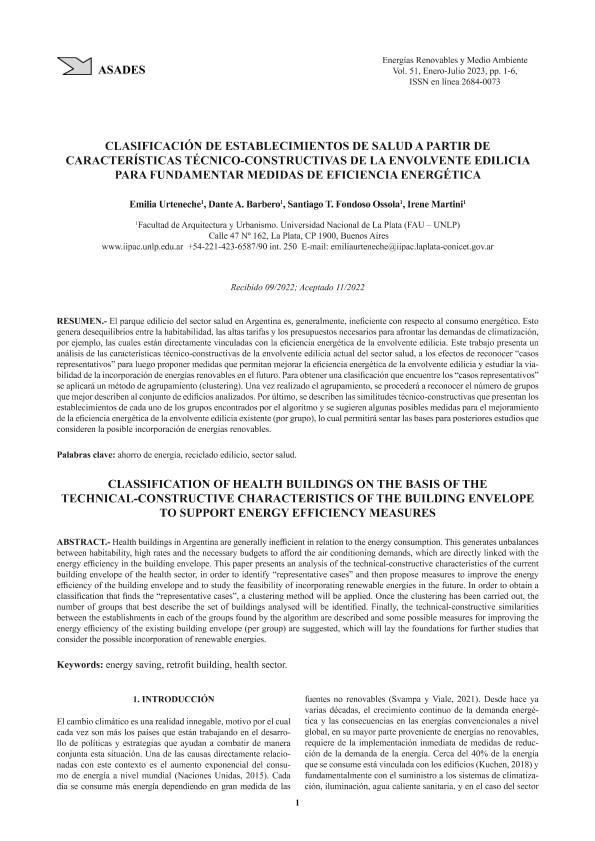Mostrar el registro sencillo del ítem
dc.contributor.author
Urteneche, Emilia

dc.contributor.author
Barbero, Dante Andrés

dc.contributor.author
Fondoso Ossola, Santiago Tomás

dc.contributor.author
Martini, Irene

dc.date.available
2024-02-16T15:45:06Z
dc.date.issued
2023-12
dc.identifier.citation
Urteneche, Emilia; Barbero, Dante Andrés; Fondoso Ossola, Santiago Tomás; Martini, Irene; Clasificación de establecimientos de salud a partir de características técnico-constructivas de la envolvente edilicia para fundamentar medidas de eficiencia energética; Asociación Argentina de Energía Solar; Energías Renovables y Medio Ambiente; 51; 12-2023; 1-6
dc.identifier.uri
http://hdl.handle.net/11336/227293
dc.description.abstract
El parque edilicio del sector salud en Argentina es, generalmente, ineficiente con respecto al consumo energético. Esto genera desequilibrios entre la habitabilidad, las altas tarifas y los presupuestos necesarios para afrontar las demandas de climatización, por ejemplo, las cuales están directamente vinculadas con la eficiencia energética de la envolvente edilicia. Este trabajo presenta un análisis de las características técnico-constructivas de la envolvente edilicia actual del sector salud, a los efectos de reconocer “casos representativos” para luego proponer medidas que permitan mejorar la eficiencia energética de la envolvente edilicia y estudiar la viabilidad de la incorporación de energías renovables en el futuro. Para obtener una clasificación que encuentre los “casos representativos” se aplicará un método de agrupamiento (clustering). Una vez realizado el agrupamiento, se procederá a reconocer el número de grupos que mejor describen al conjunto de edificios analizados. Por último, se describen las similitudes técnico-constructivas que presentan los establecimientos de cada uno de los grupos encontrados por el algoritmo y se sugieren algunas posibles medidas para el mejoramiento de la eficiencia energética de la envolvente edilicia existente (por grupo), lo cual permitirá sentar las bases para posteriores estudios que consideren la posible incorporación de energías renovables.
dc.description.abstract
Health buildings in Argentina are generally inefficient in relation to the energy consumption. This generates unbalances between habitability, high rates and the necessary budgets to afford the air conditioning demands, which are directly linked with the energy efficiency in the building envelope. This paper presents an analysis of the technical-constructive characteristics of the current building envelope of the health sector, in order to identify “representative cases” and then propose measures to improve the energy efficiency of the building envelope and to study the feasibility of incorporating renewable energies in the future. In order to obtain a classification that finds the “representative cases”, a clustering method will be applied. Once the clustering has been carried out, the number of groups that best describe the set of buildings analysed will be identified. Finally, the technical-constructive similarities between the establishments in each of the groups found by the algorithm are described and some possible measures for improving the energy efficiency of the existing building envelope (per group) are suggested, which will lay the foundations for further studies that consider the possible incorporation of renewable energies.
dc.format
application/pdf
dc.language.iso
spa
dc.publisher
Asociación Argentina de Energía Solar

dc.rights
info:eu-repo/semantics/openAccess
dc.rights.uri
https://creativecommons.org/licenses/by-nc-sa/2.5/ar/
dc.subject
AHORRO DE ENERGÍA
dc.subject
RECICLADO EDILICIO
dc.subject
SECTOR SALUD
dc.subject.classification
Ingeniería Arquitectónica

dc.subject.classification
Ingeniería Civil

dc.subject.classification
INGENIERÍAS Y TECNOLOGÍAS

dc.title
Clasificación de establecimientos de salud a partir de características técnico-constructivas de la envolvente edilicia para fundamentar medidas de eficiencia energética
dc.title
Classification of health buildings on the basis of the technical-constructive characteristics of the building envelope to support energy efficiency measures
dc.type
info:eu-repo/semantics/article
dc.type
info:ar-repo/semantics/artículo
dc.type
info:eu-repo/semantics/publishedVersion
dc.date.updated
2024-02-15T13:41:32Z
dc.identifier.eissn
2684-0073
dc.journal.volume
51
dc.journal.pagination
1-6
dc.journal.pais
Argentina

dc.description.fil
Fil: Urteneche, Emilia. Consejo Nacional de Investigaciones Cientificas y Tecnicas. Centro Cientifico Tecnologico Conicet - la Plata. Instituto de Investigaciones y Politicas del Ambiente Construido. - Universidad Nacional de la Plata. Instituto de Investigaciones y Politicas del Ambiente Construido.; Argentina
dc.description.fil
Fil: Barbero, Dante Andrés. Consejo Nacional de Investigaciones Cientificas y Tecnicas. Centro Cientifico Tecnologico Conicet - la Plata. Instituto de Investigaciones y Politicas del Ambiente Construido. - Universidad Nacional de la Plata. Instituto de Investigaciones y Politicas del Ambiente Construido.; Argentina
dc.description.fil
Fil: Fondoso Ossola, Santiago Tomás. Consejo Nacional de Investigaciones Cientificas y Tecnicas. Centro Cientifico Tecnologico Conicet - la Plata. Instituto de Investigaciones y Politicas del Ambiente Construido. - Universidad Nacional de la Plata. Instituto de Investigaciones y Politicas del Ambiente Construido.; Argentina
dc.description.fil
Fil: Martini, Irene. Consejo Nacional de Investigaciones Cientificas y Tecnicas. Centro Cientifico Tecnologico Conicet - la Plata. Instituto de Investigaciones y Politicas del Ambiente Construido. - Universidad Nacional de la Plata. Instituto de Investigaciones y Politicas del Ambiente Construido.; Argentina
dc.journal.title
Energías Renovables y Medio Ambiente
dc.relation.alternativeid
info:eu-repo/semantics/altIdentifier/url/https://portalderevistas.unsa.edu.ar/index.php/erma/article/view/4185
Archivos asociados
